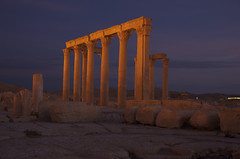Belfast, Northern Ireland, is not the most glamorous place. Conflict between Catholics and Protestants, between Loyalists and Republicans, between Ulster and Ireland has been simmering for decades, occasionally burning at the surface in hot flames. In the 80s, there weren't many days without bombings, demonstrations, paramilitary strikes and police action, or at least red-headed shoutings – spittle flying, veins bulging and all – across the walls separating hostile neighborhoods.
Belfast is more, if you dig deeper, though the associations are not necessarily much better. In the early 1900s, some of the world's largest shipyards operated on the edge of town, at the mouth of the River Lagan. It was here, at Harland and Wolff, that the RMS Titanic was launched in 1912, to eventually catastrophic consequences despite futuristically advanced technologies in the boat. Engineering glory was again pursued in the 80s, in a factory outside Belfast that rose from fields and pastures thanks to generous business development incentives. John DeLorean dreamed of building his own cars after leaving General Motors, and took the bait. Despite much enthusiasm, the De Lorean DMC-12 was the only vehicle ever to roll from the assembly line in Dunmurry. By the time the car starred in Back to the Future, its production had long ended. The manufacturer was bust and the factory had been shut down.
This was the past. Now, industrial production has nearly vanished from Northern Ireland. People work in services or government jobs, or they draw benefits. It's not a particularly wealthy part of the UK, but at least it has calmed down politically. Most mainstream parties have forsworn violence and work hard to bring communities together, deep chasms of distrust notwithstanding. Attacks and politically motivated murders still happen, but most violence is casual these days, as when youths torch cars and taunt the police because it beats yet another night in front of the telly.
The nights were quiet when I was in Belfast last weekend. A friend of mine was getting married, across cultures and across religions. He had washed ashore three years earlier, broken dreams and disappointed hopes his only baggage. Now he is the happy member of a large and very jovial Irish family and realizes that what he had considered broken dreams were in fact nothing more than the tribulations that characterize life.
The wedding took place in a Catholic church and had all the garnish of a Catholic wedding, with lots of praying and praising of the Lord. It was also a very solemn, almost regal, ceremony whose dignity was only briefly challenged when I was called to deliver a prayer for the newly-weds' happy future in front of the assembled friends and family. Chosen by the groom as one of five to speak, I felt tremendously honored but also slightly bemused. I agreed with the words I was asked to say, but it wasn't clear to me why I shouldn't say them straight into the couple's faces but use an imaginary third party as an intermediary instead.
Anyway, if I felt slightly out-of-place, the groom's mother must have truly experienced a journey to mars and back. It was the first time that she had been to Europe and her first time in a Christian church of any sort. With her traditional dark robe and beige headscarf, she wasn't someone habitually seen in this house of worship. But if there's a God, there's only one, and how you pray to it doesn't matter. So maybe she was fine, despite the visual incongruity. After all, her eldest son was getting married.
The day after the celebration, I was treated to some of the background behind the drab facade of dirty brickwork, fading paint and littered strip mall parking lots that characterize some of the outskirts of Belfast. My friend drove me through the western fringes of town. In some of the more deprived areas, feelings of belonging and betrayal still run strong, and history is a continuous guide. The past must never been forgotten. Community and enemy are very clearly defined, and blaringly displayed on murals and with flags. Much remains of the wall that separates the Republican Falls Road from the Unionist Shankhill, and barbed wire tops many a fence. The heavy steel gates are still there, though they're open now, and in places the barrier almost looks like the Berlin Wall's little sister. Hard to imagine that people in the developed world still get worked up, to the point of hate and violence, about questions of nationality, religion and inequities of the past.
